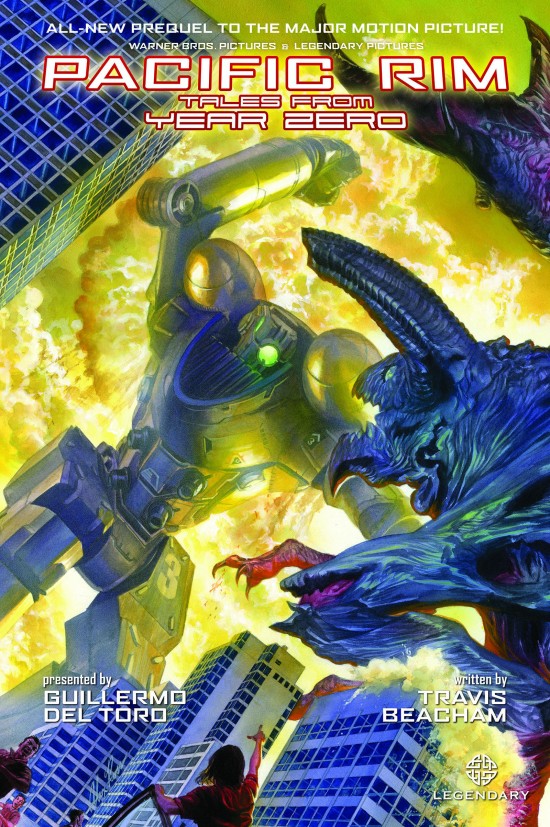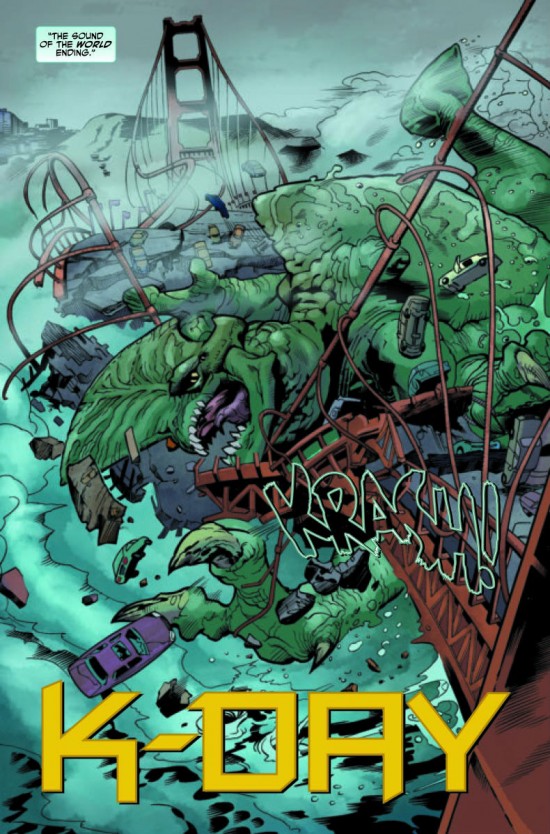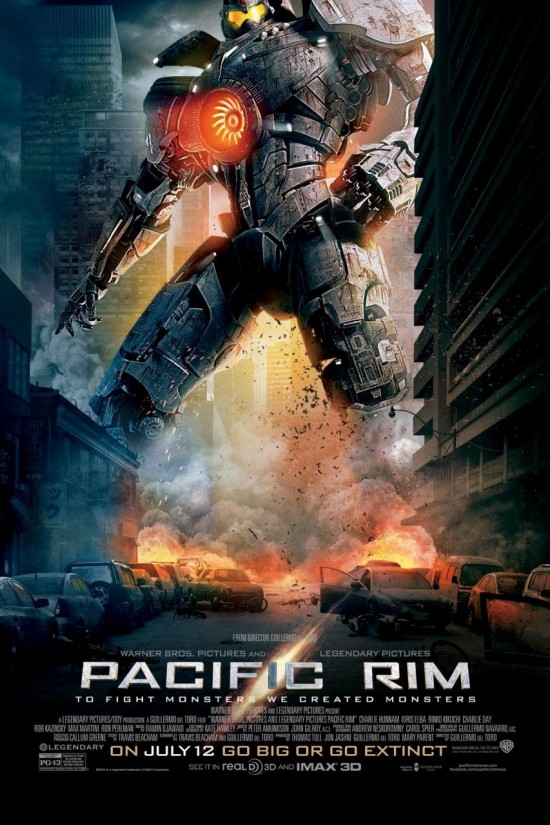/Film Interview: 'Pacific Rim' Screenwriter Travis Beacham Discusses How 'Tales From Year Zero' Influences The Film
While Guillermo del Toro will likely get the credit, good or bad, once Pacific Rim comes to theaters, it was Travis Beacham who got him there. It was Beacham who, while walking on the beach, cracked the idea to pit giant robots against giant monsters in what eventually became this summer's film. Beacham was the one who developed it and got it to Legendary; and only then did del Toro take over and make it his own.
So while the director went off and made a movie for us all to enjoy on July 12, Beacham got to work on expanding the film's backstory. He's hard at work on a sequel and also wrote a prequel graphic novel that's now in stores. Pacific Rim: Tales From Year Zero is set before the film, explaining what happened the first time the Kaiju attacked Earth, and how the Jaeger program was started. Characters played by Charlie Hunnam, Idris Elba, Rinko Kikuchi and Clifton Collins Jr. all appear in the novel, expanding on their motivations, fears and personalities. It's an entertaining read that can only make Pacific Rim better.
We spoke to Beacham about the book, specifically how several of its smaller details might wind up playing out on screen once Pacific Rim hits theaters. He also touched upon how the director influenced it, how far along Pacific Rim 2 is, some hints at what we might see there and how the film features his favorite scene Guillermo del Toro has ever done.
 Be aware that some spoilers for the Pacific Rim graphic novel follow./Film: I read the comic over the weekend and it got me even more excited for the movie, which was kind of impossible. How much of the backstory, if any, was in the script at any stage that ended up in the novel?
Be aware that some spoilers for the Pacific Rim graphic novel follow./Film: I read the comic over the weekend and it got me even more excited for the movie, which was kind of impossible. How much of the backstory, if any, was in the script at any stage that ended up in the novel?
Travis Beacham: Not really any of it, I think. I mean it was sort of something we had been thinking about for a while, not specifically in the context of a graphic novel, but in putting the world together and figuring that out and sort of figuring out the process of the movie and the history of the in world story. You know, we came up with a few of these beats already, so when it came time to talk about the graphic novel, it just seemed like a natural thing to dramatize rather than just sort of duplicating the events of the movie.
So you're essentially reverse engineering stuff? Like "I created this character beat for Charlie Hunnam's character, so let's delve into that a little bit"?
Yeah, there is sort of a beat with the character of Raleigh that was in the first draft of the script, that I think you get in the third part of the comic and a bit more of it in downscaled versions. Things like the eureka moment where Dr. Schoenfeld figures out the idea for the jaegers. He's watching his kids play with their toys on the floor. That was sort of part of the mythology all along, but had never really been included in the draft. So yeah, and some of it is just stuff that we figure out along the way in putting the graphic novel together and using these headline moments to go there in kind of a dramatic narrative.
So the movie started as your pitch and then Guillermo came on later but Guillermo was reportedly "hands on" with this graphic novel, too. What exactly does that entail?
He approved the scripts. He was in the loop very early on. I think at the beginnings... I don't think he was still on set, but he was editing the movie and I think getting it together, so he was really hip deep in that and sort of became more involved as his time allowed, but he always wanted to be in the loop and he was a big fan of doing the graphic novel this way and by the end when we were getting pages, his notes were very, very specific. He definitely had a lot of opinions about how it was put together.
Early in the graphic novel we see Gipsy Danger being taken away. Is that something expanded upon in the movie?
What you're seeing in the graphic novel actually takes place in a time that's sort of between the pre-title opening sequence of the movie and the rest of the movie. That's where the framing sort of takes place. Despite that, I think it does fit that and does suggest a few things that happen in that opening scene, but nothing Guillermo or I would consider major spoilers.
The two things from the book that weren't really fully explained were that Gipsy Danger is being pulled away, and he's the hero robot we've seen in all of the marketing. Also, they keep referring to this "Wall" and that's the reason they stopped the jaeger program. Are those two things stuff that is in the movie?
Yeah. That's sort of the world we are coming into in the movie. This was partly the leaked part of the world we are stepping into which the movie goes to expose, and they've sort of... The governments of the world have deferred to this "Wall" program, because the jaegers need repairing after they get busted... The Kaiju are getting stronger. More and more of them are coming out. It's just becoming more and more expensive, so this wall has become a plan B that's very gradually becoming a plan A. That's the world that you come into in the movie.
And the other main characters in the graphic novel: Naomi, Tendo, Jasper, are they at all in the movie or do they just exist in the graphic novel?
Tendo is played by Clifton Collins Jr. and you can see him in some of the trailers. He's the guy in the trailers who is sitting at the consoles in the control room. Naomi and Jasper are not in the movie.
 All right. Now with the first Kaiju attack, in San Francisco, [above] they win by nuking the Kaiju. Does the film deal with the fallout of detonating a nuclear bomb on US soil?
All right. Now with the first Kaiju attack, in San Francisco, [above] they win by nuking the Kaiju. Does the film deal with the fallout of detonating a nuclear bomb on US soil?
Sort of. The way that the movie is kind of set up is for the most part is it takes place a good twelve or so years into the war, so the first Kaiju attack and the first jaeger are in the movie's past. It introduces you to all of those concepts, but the movie is more focused on a few characters rather than on the world as a whole. It's sort of a drop in in the style of Blade Runner or something where you're in this world that has a lot of texture and history and all of that, but really you are with just a handful of people and the problems with the drama are their problems and their dilemmas and the dilemmas of the world sort of interface with that.
There are three Kaiju attacks before they really get the jaeger program going, I believe. So is there any explanation, or is it just sort of "this is how we make movies" that the Kaiju stop coming and give us the time to develop this technology?
No, they didn't necessarily stop coming. Part of it is just that we did it really fast. We got it together really fast. The inspiration for the whole time frame there is the Apollo program. If you look like in 1960, there was no such thing as an astronaut, it was a totally fanciful concept, but nine years later or whatever we were landing on the moon, which is just astonishing.
It's an astonishing leap in technology and for the most part it was because of the fear of the Soviets and this is kind of the same principle where the fear of these giant monsters has sort of triggered an unusually quick development in technology.
There's also this beautiful moment in the graphic novel where the doctor, Caitlin Lightcap, figures out almost by accident that you need at least two minds to run a jaeger. That seems like such an important concept to the entire story. Do we have a similar moment in the movie, like this is your "Eureka" moment? Or is it just sort of alluded to in the backstory once we start the movie?
It's a given once you get into the movie, but it is... That idea is critical to this story and the movie. I always feel like there just wouldn't be a Pacific Rim without that idea. Like that idea is sort of at the heart of the entire world of Pacific Rim. I think I would still be walking around vaguely hoping somebody would make a giant monster versus robot movie if I hadn't realized there were two pilots.
There's an almost ethereal place when those two people meet in their minds. Is there a visual representation of that or is that similar to what we see in the film?
We don't make much of it in the film. I think in the first draft there was a bit more stuff that took place like that, that head space, but I think ultimately for a first movie it was decided not to spend much time there or play around with it that much. It would be kind of a third buy for the audience to make in a big movie. I think we are going to get into that later, definitely if there are further incarnations of the story. That's definitely part of the mythology we want to explore a bit more. With the graphic novel or hopefully sequels or that sort of thing. There is one part in the movie that really deals with it and it may by my favorite sequence I've ever seen Guillermo direct. I love, love this one bit in the movie. It's where memories drift and I think it's just really well done.
You mentioned you guys were thinking about a sequel. Obviously nothing is official yet until the movie comes out and audiences dig it, but how far along is that process now? Do you guys just have some outlines, general ideas, or have you actually started writing script pages?
Oh yeah. Yeah, I've started writing page one. It's been a very... and this has come at the end of some very active conversations we've had about it. I'm sure the first of many, many conversations we will have about it, but I'm sort of formally or informally putting scenes together and that sort of thing.
Last thing. It's a pretty interesting time for you. We are talking about this movie you have coming out, then you have the graphic novel with a lot of really good information that sets it up. What's it like to have see people getting excited for this huge movie that you're so passionate about?
For me it's really incredible and it's a moving experience even, because it starts off very quietly. You're by yourself in the beginning and you have nothing to go on as to whether or not it's special, just apart from your own instinct or desire to feel. And having seen what Guillermo's done with it and the life he's brought to it, and what the cast has done with it and how they have sort of made their characters their own, I think it's just one of those things where everyone involved has miraculously and against all odds been picturing the same movie. That's just a really rare experience. I think this idea has always been a favorite of mine and if I would hope to get through the rigors of Hollywood relatively unscathed on the other side. I think it would be this one. It's just been... I just keep waiting for the other shoe to drop, you know? It's been a very positive experience.
Pacific Rim: Tales From Year Zero, written by Travis Beacham with art by Sean Chen, Yvel Guichet, Pericles Junior, Chris Batista and Geoff Shaw, is in book stores now. Pacific Rim opens July 12.
